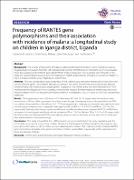| dc.description.abstract | Background: The severity and outcome of malaria is influenced by host immunity in which chemokines such as
Regulated upon Activation, Normal T cell Expressed and Secreted (RANTES) play an important role. Previous studies
show that variations in the RANTES gene affect RANTES protein production, hence altering host immunity. In this
study, the relationship between presence of mutations in RANTES and incidence of malaria in a cohort of children living
in a malaria-endemic area of Uganda was determined.
Methods: This was a longitudinal study comprising of 423 children aged between 6 months and 9 years, who were
actively followed up for 1 year. Malaria episodes occurring in the cohort children were detected and the affected
children treated with national policy drug regimen. Mutations in the RANTES gene were determined by PCR–RFLP
method and their frequencies were calculated. A multivariate negative binomial regression model was used to estimate
the impact of RANTES mutations on malaria incidence. In all statistical tests, a P-value of <0.05 was considered as
significant.
Results: The frequencies of the −403A and In1.1C allele were 53.7 and 19.2 %, respectively. No mutations were
found at the −28 locus. After adjustment of incidence rates for age, blood group, insecticide-treated bed net (ITN)
use, malaria history and the sickle cell trait, 1n1.1T/C heterozygotes and homozygotes showed a non-significant trend
towards higher incidence rates compared to wild-type individuals (IRR = 1.10; P = 0.55 and IRR = 1.25; P = 0.60,
respectively). Similarly, there was no significant difference in malaria incidence rates between RANTES −403G/A heterozygotes
or homozygotes and those without mutations (IRR = 1.09; P = 0.66 and IRR = 1.16; P = 0.50, respectively).
No relation was seen between RANTES polymorphisms, baseline parasite densities and the time to first re-infection
after administration of anti-malaria drugs.
Conclusions: This study showed that the −403A mutation occurs in nearly half of the study population and the
In1.1C allele occurs in one in every four children. Despite the high frequency of these mutations, there was no clear
association with malaria incidence. Other studies evaluating more markers, that could potentially modulate RANTES
gene transcription alongside other genetic modifiers of malaria susceptibility, may provide further explanations to
these less dramatic findings. | en_US |

